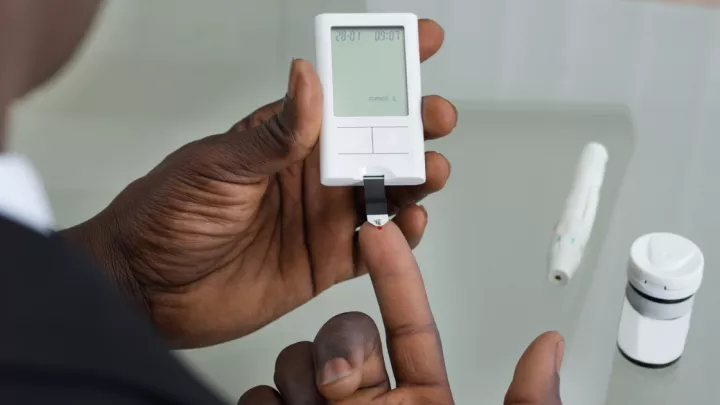Understanding the A1C test and diabetes

If you’re managing diabetes or know someone who is, you’ve likely heard about the importance of the A1C test. The A1C test, also known as the hemoglobin A1C or HbA1c test, is crucial in diabetes care and management. It provides a snapshot of your average blood sugar levels over the past three months and monitors its management.
“Glucose sugar in your blood sticks to the hemoglobin, and with the A1C test, we can see what percentage of your red blood cells are coated in sugar,” says Nebraska Medicine Outpatient Diabetes Educator Melissa Lockard, RN. “From that, we can determine the average blood glucose level over three months.”
Whether you’re newly diagnosed or have been living with diabetes, understanding your A1C levels can help you take control of your health and make informed decisions.
Why an A1C test is done
An A1C test measures your blood sugar levels over the past three months because that’s how long it takes for red blood cells to regenerate. Blood sugar levels constantly change, so the A1C test gives a complete picture of someone’s progress. It can help diagnose prediabetes, Type 1 and Type 2 diabetes. Depending on the type of diabetes and your treatment goals, getting tested regularly is recommended.
“For pre-diabetic people, we recommend checking their hemoglobin A1C annually,” says Lockard. “If someone has well-controlled diabetes and they don’t take insulin, we recommend testing every six months. Those with uncontrolled diabetes who take insulin should be checked every three months.”
If someone hasn’t been diagnosed with diabetes but has the following symptoms, an A1C test might be recommended:
- Increased thirst and urination.
- Blurry vision.
- Extreme fatigue.
- Excessive hunger.
- Numbness in feet.
An A1C can also screen for Type 2 diabetes if there’s a family history, obesity, lack of exercise or being over 35 years old.
What can you expect during an A1C test?
Tests are typically done in a doctor’s office with a simple blood draw from the vein. The blood test is sent to a lab for analysis. A finger stick may also be done. Some choose A1C home tests for continuous glucose monitoring.
“Home A1C tests are considered to be accurate,” says Lockard. “The results can vary by an average of 0.5%, which is acceptable per the FDA. We recommend testing at a doctor’s office for accuracy.”
What does your A1C mean?
The A1C test gives you a percentage representing the number of hemoglobin proteins coated in glucose. If your percentage is higher, your blood sugar levels are elevated. Typically, if your result is less than 5.7%, you don’t have diabetes. Prediabetes falls into the 5.7% to 6.4% range, while 6.5% or higher indicates Type 1 or Type 2 diabetes. The American Diabetes Association recommends an A1C of 7% or lower for most adults. Dangerous A1C levels can be consistently over 7% to 9%.
“If someone consistently has a hemoglobin A1C over 7% over a prolonged time, we have an increased risk of nerve damage, as well as damage to the blood vessels in the kidneys and behind the eyes,” says Lockard.
A1C tests are considered accurate, but certain factors can impact the results.
“A single hemoglobin A1C reading over 6.5% doesn’t mean you have diabetes,” says Lockard. “If you’re on medications that cause high blood sugar, such as steroids, those numbers can be more elevated. If you’re under mental, emotional or physical stress, that can impact the numbers too.”
Additionally, different situations and conditions can cause false A1C results. These results can read lower than the levels actually are.
“Sometimes we anticipate numbers being incorrect,” says Lockard. “Any health condition impacting red blood cells such as alcohol use disorder, chronic kidney disease, blood transfusions or pregnancy can impact the A1C readings.”
Can A1C be lowered?
With proper lifestyle changes, A1C can be lowered. The best way is through regular exercise and making healthier food choices.
“Be mindful of how many carbohydrates you consume – we don’t necessarily want people to eliminate them, just reduce the amount,” says Lockard. “If you drink soda, switch to sugar-free or drink water. The American Diabetes Association recommends 150 minutes per week of exercise, or 30 minutes daily for five days.”
If you’ve been prescribed insulin, take it as prescribed. Taking the medication you’ve been prescribed and sticking to your treatment plan can keep your blood sugar levels under control.







